REMEMBRANCE
OF
THE FIRST WORLD WAR
POPPIES AT THE TOWER
NOVEMBER 2014
-oOo-
PAGE ONE: CENTENARY
-oOo-
INTRODUCTION: THE GREAT WAR & REMEMBRANCE
Blood Swept Lands and Seas of Red
Poppies at The Tower of London, July-November 2014
-oOo-
My photographs of the Poppies at The Tower of London may be seen by clicking here
-oOo-
Britain’s entry into the First World War was on 5th August, 1914.
-oOo-
Between July and November 2014, 888,246 ceramic poppies were planted in The Moat of The Tower of London. The placing of poppies here is an example of Installation Art with the title of Blood Swept Lands and Seas of Red, which is the first line of a poem (* see below) by an unknown soldier who fought in the First World War (and not to be confused with the more famous, In Flanders Fields). Each poppy represents a British or Colonial serviceman who was killed during the War and is the work of the artist, Paul Cummins, with setting by the stage designer, Tom Piper.
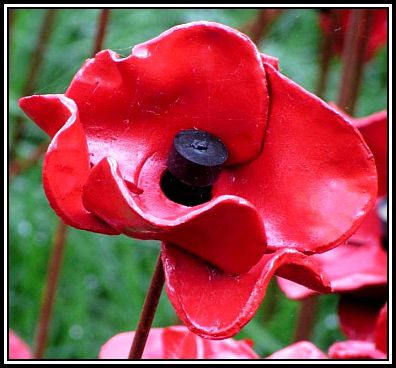 One Ceramic Poppy (photograph taken by Steve Keene-Elliott)
One Ceramic Poppy (photograph taken by Steve Keene-Elliott)
Each ceramic poppy was individually made by hand at Cummins’ Ceramic Works in Derbyshire with some being made at Johnson Tiles, Tunstall, Stoke-on-Trent. The first Poppy was planted on 17th July, 2014 and the field was officially unveiled on 5th August, the centenary of Britain’s entry into the First World War. A total of 17,500 volunteers placed the poppies in The Moat with the last being planted on Remembrance Day, the 11th November, 2014.
Click here to watch the video, Making the Poppies, The Tower of London Remembers
Click here to watch the video, The Tower of London Poppies
The day following Remembrance Day saw ~8,000 volunteers descend on The Moat and begin to remove the Ceramic Poppies. The public had been able to pre-order the poppies for £25 each and all were sold and raised over £8 million for selected charities.
-oOo-
*BLOOD SWEPT LANDS AND SEAS OF RED
BY
AN UNKNOWN SOLDIER
The blood swept lands and seas of red,
Where angels dare to tread.
As I put my hand to reach,
As God cried a tear of pain as the angels fell,
Again and again.
As the tears of mine fell to the ground,
To sleep with the flowers of red,
As any be dead.
My children see and work through fields
of my own with corn and wheat,
Blessed by love so far from pain of my resting
Fields so far from my love.
It be time to put my hand up and end this pain
Of living hell, to see the people around me
Fall someone angel as the mist falls around,
And the rain so thick with black
thunder I hear
Over the clouds, to sleep forever and kiss
The flower of my people gone before time
To sleep and cry no more.
I put my hand up and see the land of red,
This is my time to go over,
I may not come back
So sleep, kiss the boys for me.
-oOo-
This poem, Blood Swept Lands and Seas of Red, which was written by an unknown soldier, should not be confused with the poem, In Flanders Fields, written by Lieutenant Colonel John McCrae (1872-1944) who was a Canadian and a physician during the War. (See Page 3 for more on this subject.)
-oOo-
THE FIRST WORLD WAR
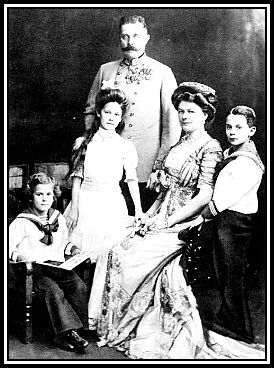 Archduke Franz Ferdinand, his wife, Sophie and their three children (1910); from the Imperial War Museum Collection
Archduke Franz Ferdinand, his wife, Sophie and their three children (1910); from the Imperial War Museum Collection
On 28th June, 1914, the Austrian Archduke Franz Ferdinand (1863-1914), heir to the Austro-Hungarian throne, and his wife, Sophie, were assassinated in Sarajevo, the capital of Serbia, by members of the nationalist group, Mlada (Young) Bosna. As a result of this, and earlier ill-feelings, the situation escalated into The Great War, or The War to End all Wars.
On one side were the Allies consisting of the Triple Entente, the United Kingdom, France and the Russian Empire, and with the Central Powers on the other, which consisted of Germany and Austria-Hungary. As the war progressed, Italy, Japan and the United States joined the Allies and the Ottoman Empire and Bulgaria, the Central Powers.
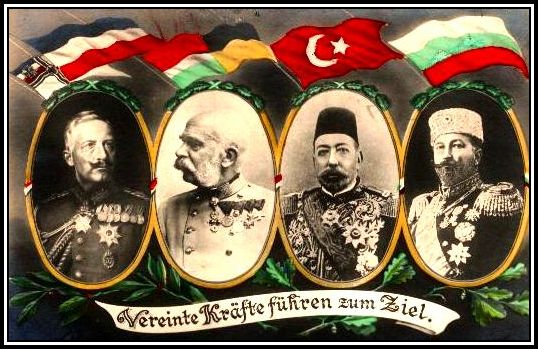 Postcard of the leaders of the Central Powers
Postcard of the leaders of the Central Powers
From Left to Right: Kaiser Wilhelm II of Germany; Kaiser and King Franz Joseph of Austria-Hungary; Sultan Mehmed V of the Ottoman Empire; Tsar Ferdinand of Bulgaria
-oOo-
By the time The Great War ended on 11th November, 1918, over nine million members of the armed forces and seven million civilians had been killed.
With the end of the war, the German, Russian, Austro-Hungarian and Ottoman Empires no longer existed. New borders were drawn in Europe and the German colonies were shared amongst the victors. A number of treaties were signed during the Paris Peace Conference of 1919 and The League of Nations was formed in 1920 with the hope of preventing any further warfare. The League failed as a result of weakened states, economic depression and the revival of nationalism together with feelings of humiliation by Germany.
These situations led to the rise of National Socialism (Nazism) with the eventual declaration of The Second World War that brought further mayhem.
-oOo-
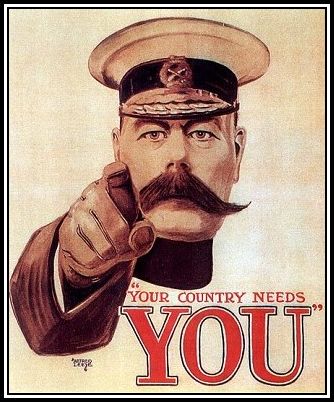 Recruitment Poster of Lord Kitchener.
Recruitment Poster of Lord Kitchener.
According to Mr. James Taylor, this poster was not actually used to encourage recruitment into the armed services during The First World War. It was designed by Alfred Leete (1882-1933), a graphic artist, for the cover of the magazine, the London Opinion, published on 5th September, 1914.
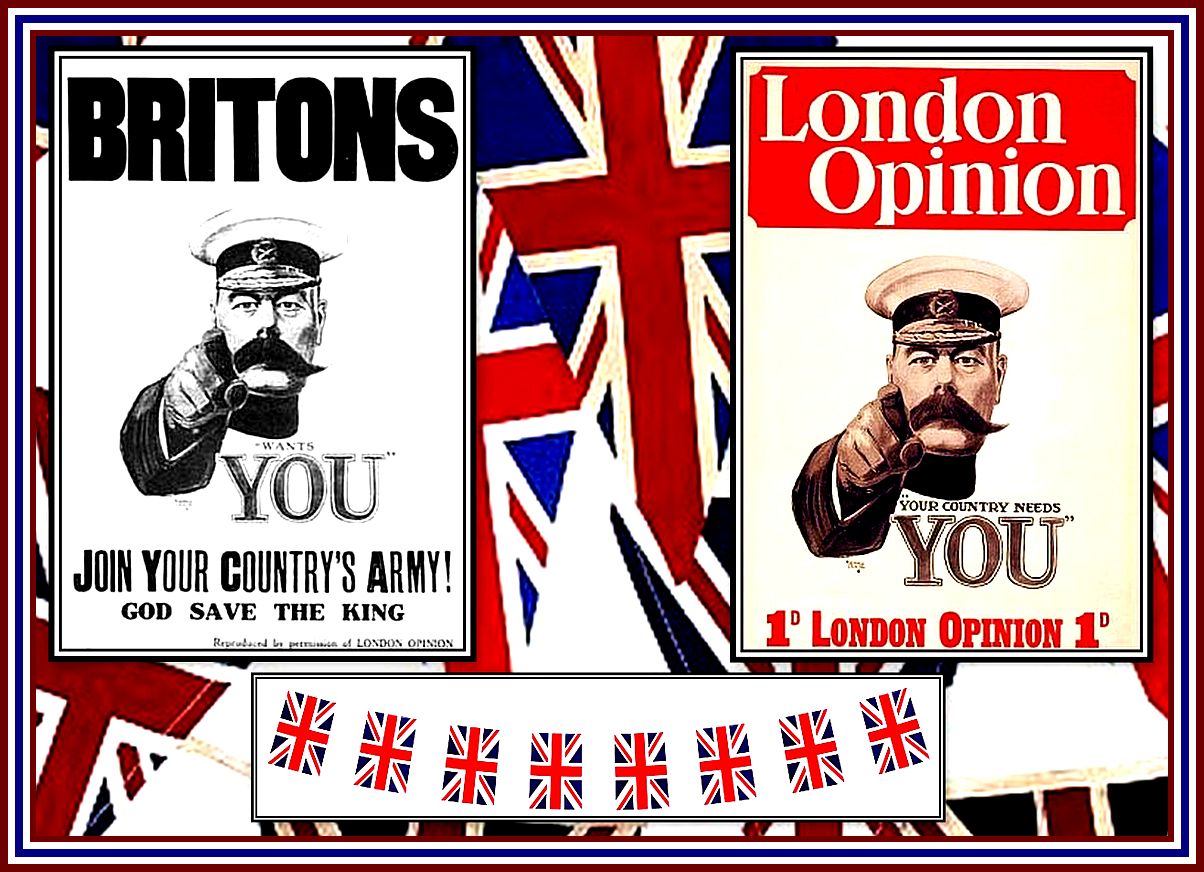 Alfred Leete’s Original Poster (Left) and Cover of the London Opinion (Right)
Alfred Leete’s Original Poster (Left) and Cover of the London Opinion (Right)
Following the war, the poster was miscatalogued by The Imperial War Museum and stored with recruitment posters. thereby contributing to the later misunderstanding regarding its use.
-oOo-
Click here
to read more about
POPPIES AT THE TOWER
——oooOOOooo——
Click here to GO to the POPPIES AT THE TOWER – PAGE 2
——oooOOOooo——
Click here to RETURN to the TABLE OF CONTENTS
——oooOOOooo——

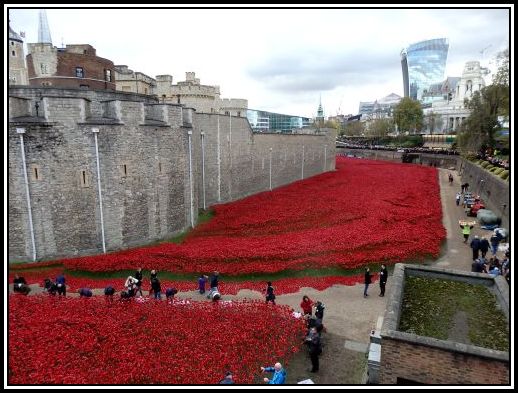
Nice job, Charles. We visited the Tower and the poppies earlier this year. The crowds were massive, but quite orderly and kept moving along so that everyone could get a view. No pictures can do justice to how powerful the image was.
Magnificent photographs from all angles and those cascading down the wall. Brilliant idea.
I did manage to see on the website, inside the factory where the ceramic poppies were being made.
I feel sad for your mother losing two close relatives during the war.